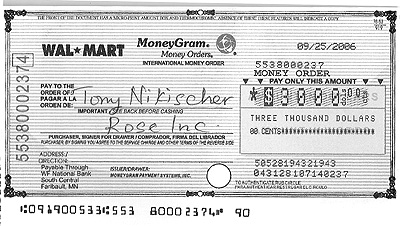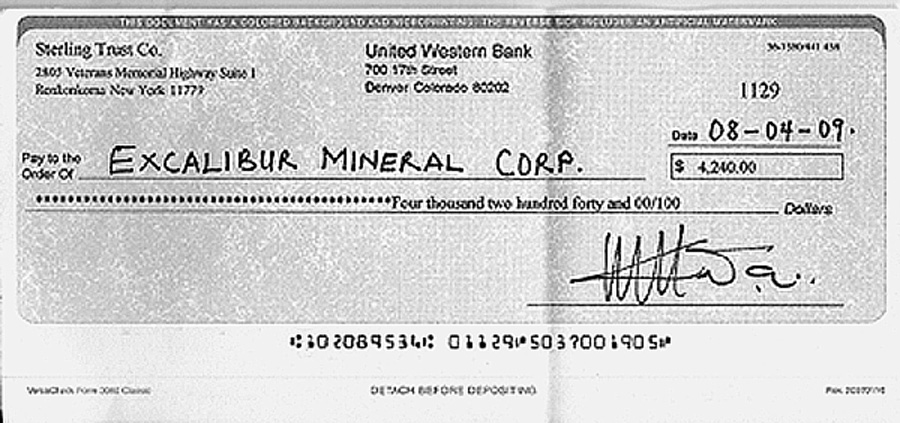An Article In Meteorite-Times Magazine
by Robert Verish
![]()
An Article In Meteorite-Times Magazine
by Robert Verish
New Fraud Tactics in the Mineral Trade
A recent article in Mineral News by its editor, Tony Nikischer.
Revelations by Tony Nikischer, editor of theMineral News magazine, of sophisticated attempts at fraud in the mineral trade, have prompted other editors to "spread the word" and to alert all dealers and vendors in similar trades to be on the look-out for this new version of an old swindle:
New Fraud Tactics in the Mineral Trade
By Tony Nikischer
Excalibur Mineral
Corp.
While
mineral collectors as a group are probably among the most honest of
individuals, new fraud tactics have slowly crept into the mineral trade, much a
result of the instantaneous nature of the internet age. Whenever and wherever
money is to be made, there will always be unscrupulous individuals who will try
to make it, take it, or just plain steal it, without regard to right, fairness
or legitimate ownership. And this seems to be occurring now in our hobby, from
a dealer’s perspective, with alarming and widespread regularity.
As
a mineral seller for more than thirty-five years, I can attest to the generally
reliable and honest nature of the vast majority of collectors and dealers. I
can count on one hand the number of bad checks and disappearing customers who
have successfully made off with the spoils of mineral theft from my firm during
that time. There were, certainly, a good number of scoundrels to be dealt with
from both sides of the table, but in our small community, it was easy to spot
them, and their names were soon known to all. Loose organizations like the
Species Mineral Dealers’ Association in the early 1980’s were good vehicles for
identifying collector miscreants, and they were quickly shunned by the selling
community as a whole. Likewise, dealers who doctored labels, misrepresented
specimens or knowingly sold specimens with significant, undisclosed repairs
became quickly ostracized.
Beginning
in 2003 and perhaps earlier, as the internet crept into the corners of many
third-world countries, new scams assailed email users by the carload! “I will
give you a share in the $5,000,000 my uncle, a deposed general, hid from the
ruling junta before he died, if you can advance me the $4,700 I need to secure
it and bring it out of the country. I’ll come and pick it up as soon as you can
have it ready.” Or how about: “You’ve
won $175,000 in our lottery, all we need is your social security number and
bank info so that we can transfer it into your account right away!” A modern
favorite: “Your Pay Pal account has been compromised; click here to
unlock your account and set up new security passwords.” Really!
While
it was fun to spot the obvious crooks and sometimes string them along
(notifying the Nigerian embassy, the FBI, the local gendarmes etc. was useless,
of course), their efforts were often crude and unconvincing for most. (I recall
suggesting to one faker that I knew he was holding out on me, because his
brother was offering me twice as much from the hidden gold cache he was
describing. Imagine my delight when he confessed to doing so, and now he was
willing to let me have it all as a measure of his goodwill!)
Recently,
however, it has become clear that a new breed of thief has infiltrated the
mineral market from the customer side, often facilitated by the speed of
communication and commerce that typifies today’s internet-driven markets. It is
also clear, however, that many of these modern thieves often have little interest
in minerals; it is still just plain old money that drives them. But now, their
targets are more frequently directed to small, internet-based merchants that so
typify many of today’s mineral dealers.
As
early as 2006, the use of completely fraudulent checks and money orders began
to appear with some regularity in the mineral trade. Many were exceptionally
well done, a credit to the printer’s art of counterfeiting (see illustrations - Editor). The typical
scam would go something like this:
An email arrives from a “new customer” who wants to
know what the dealer has available in XXXXXXXX. The dealer dutifully responds
with a quote, perhaps some photographs, perhaps a few links. The “customer”
writes back via email that he will pay by bank check (or money order, or
certified check), and he wants ten (10) of that item – and the money is already
on the way- can you ship them immediately?
Well, no one in their right mind ships expensive
merchandise to unknown clients these days without seeing the money first, and
besides, you only have one of these, not ten! You advise the “customer” by
email accordingly, and he says, “No problem, prepare it for shipment, but the
money is already on the way.” Lo and behold, the bank check/money
order/certified check arrives shortly thereafter, made out for ten times the
value of what you can ship.

Within a day, the “customer” calls or emails, saying,
“Just ship the one you have now (immediately by Express Mail, by FedEx etc..) to my office in
Perhaps
you accept credit card payments, as most dealers do these days. You should
immediately be wary when a “new customer” emails you, asking if you accept
credit cards, and do you ship to YYYYYYYYY (where “Y” can be
Well,
here’s someone who has probably secured thousands of email addresses using a
web crawler, and they have sent that same message to those thousands of
merchant email addresses. If they were a legitimate mineral collector, they
would likely know your web address, what you sell, and, in all likelihood, what
forms of payment you accept, where you ship to, how you ship, etc. They are
setting you up for a fraudulent credit card transaction, using a stolen or
bogus credit card. Should a dealer ship an expensive item, only to discover the
card was stolen, it becomes a major undertaking to attempt reimbursement either
through the card processor, your bank or through private insurance. Your
material is gone regardless, most likely soon to be sold off elsewhere.
Another
scam now emerging with some regularity is what I call “the one time customer
double bill”, a take off of the old “I never received your package” scam.
Unfortunately, some of these perpetrators appear to be genuine mineral
collectors who are just trying to steal specimens for their collections. They
often disappear after their first “buy”, and you’ll recognize them after the
fact. Their scenario usually works like this:
A “new customer” makes a few inquiries, eventually
settles on a sizeable order, and pays with a debit card. Within a day or two of
shipping the items, you get a frantic telephone call and a couple of emails
stating that you double-billed their card, and they
want you to immediately credit one of the double billings to their account. As
proof, they send you an email copy of their “on-line banking statement” (less
account numbers and other pertinent info) that shows your transaction posting
twice to their account. On top of everything else, they are not happy with the
order and are filled with complaints about the material you shipped.
Mistakes do happen, but if you don’t check thoroughly
at your end, you are about to lose the specimens and the credit/debit card
deposit if you issue an immediate refund. Quite simply, there is no double
billing. The statement they have emailed you is an electronic fake, carefully
composed for your benefit. In your haste to mollify a seemingly and rightfully
irate and unhappy customer, you may simply issue the credit/refund without due
diligence. You may even forget about it once it is buried with other
transactions of the day. The customer will probably never be back, nor will you
have any success in getting your money or material back. You have lost once
again. The lesson: be patient, investigate with your own bank and card
processor before succumbing to the double billing ploy.
I
have started to build a small collection of bogus financial devices like those
illustrated in this article. Some are well-executed, some are crude, all are dangerous to the unwary dealer.
The
unfortunate caveat to dealers: be suspicious of large transactions from unknown
customers that require you to ship immediately or have picked up at your place
of business. Be especially wary of large overpayments or supposed billing
errors that require immediate and substantial refunds. Use your bank or credit
card processor’s fraud detection capabilities before processing such payments
and refunds. No one in authority will be interested in aggressively pursuing
these thieves once you have been stuck, so be careful! Dealers
who would like to learn of assorted, satisfying vengeance tactics against these
predators, please email me for some harmless but immensely annoying scams of
your own that can be directed back to the source of your pain….

| Mineral News
was founded some twenty years ago by Lanny Ream of Coeur d'Alene, Idaho,
author of the book "Idaho Minerals". Over the years, it developed
a following of avid mineral collectors seeking timely information about
new finds and other items of interest to the collector community.
With the purchase of Mineral News by Excalibur Mineral Corp in 2003, the monthly newsletter has expanded to sixteen pages a month, revitalized its look by improving paper and print quality, and it has added significant features such as frequent book reviews, photographs to supplement new mineral descriptions and a greater focus of articles directed to descriptive mineralogy. |
 |
The Sid and Betty Williams Laboratory for Mineralogical Research:
Founder and Chairman of the Institute, Tony Nikischer
For for more information, please contact me by email:
Bolide*chaser
